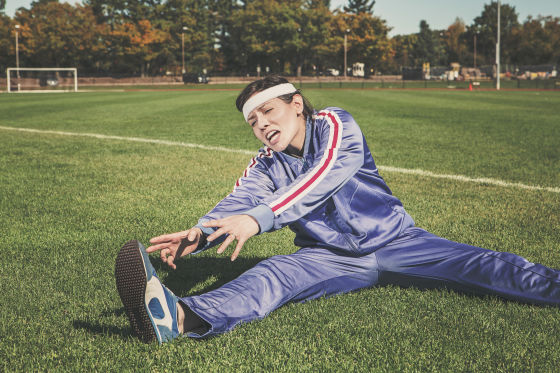A person who vowed to lose weight this year scientifically explains how to burn fat effectively with 30 minutes of training

by
There are many ways to burn calories, but scientifically speaking, exercising in a 30-minute time frame is the most efficient, and this method is called ' high-intensity interval training .' If you understand the scientific mechanics behind high-intensity interval training, you should be able to train in a way that suits you, so health and science reporter Katherine Ellen Foley burns calories efficiently. Explains the science to go.
What's the best way to burn calories in a short amount of time? — Quartz
https://qz.com/1160945/the-scientifically-best-way-for-you-to-maximize-the-number-of-calories-you-can-burn-in-a-workout/
High-intensity interval training is a type of cardiovascular exercise that repeats high-intensity, short-term anaerobic exercise while sandwiching incomplete recovery. In this training, both the heart and muscles are trained, so in order to keep the heart rate rising, we will perform 'jump lunge' that combines lunge and jump and 'jump squat' that combines squat and jump.
The jump lunge looks like the following.
Jumping Lunges --Alexandra Bring --YouTube
This is a jump squat.
Jump Squat --YouTube
There is also a method called 'burpee'.
How to Do a Burpee --YouTube
As you can see, what is included in high-intensity interval training is very intense and can be painful for some people. However, it is far more effective than walking or jogging, which uses partial muscle strength and reduces the burden on the cardiovascular system. High-intensity interval training is for maximizing the cardiovascular system and multiple different muscle groups.
◆ How does our body burn calories?
Our body burns calories at the cellular level to produce energy, but this process depends on 'how much oxygen is available.'
Humans convert carbohydrates taken into the body into glucose , which is eventually stored in the body as fat, but when exercising, cells break down glucose into adenosine triphosphate (ATP) to produce energy. The process of converting glucose to ATP involves three different chemical reactions, all of which are 'aerobic metabolisms' that require oxygen. According to Rick Kreider, an exercise physiologist at Texas A & M University, 1 liter of oxygen is needed to burn 5 kcal.
And the muscles attached to the trunk, arms, legs, etc. are like an expansion engine attached to the bones, and have a structure that quickly creates ATP when needed. When you do push-ups or squats, the muscles in your body consume energy, so you can consume more energy by growing the muscles of each part of your body.
Theoretically, a person can burn 2000-3000 kcal by exercising for 1 hour with maximum oxygen intake.
However, the human circulatory system has a limit to the amount of oxygen that can be handled at one time, and in reality it cannot burn 2000 to 3000 kcal in one hour. When this 'aerobic threshold' is exceeded, the human body goes into a state of 'anaerobic metabolism', and the muscles use energy but no oxygen is supplied. Anaerobic metabolism does not produce ATP compared to aerobic metabolism, and instead of producing carbon dioxide, water, and heat, it produces lactic acid as a by-product. Lactic acid causes pain in the muscles, and as a result, it also causes people to move away from exercise.
However, the state of anaerobic metabolism lasts up to 180 seconds, but when it reaches a certain point, it slows down or stops metabolism. This is considered one of the evolutionary adaptations, in which the body is once again able to circulate oxygen.

by
Considering the above, how much calories are burned during exercise is determined by 'how to maximize the aerobic threshold while consuming energy' and 'body composition'.
To keep burning calories, you need to keep your energy expenditure just below the aerobic threshold, which is very difficult. Tour de France cyclists reach the aerobic threshold with 85-90% exercise intensity, but for those who are not exercising, such as going to the gym on a regular basis, 60-65% exercise intensity Will reach the aerobic threshold. Therefore, it is necessary to raise the level of the aerobic threshold by increasing the ability to supply oxygen to the muscles, that is, the capacity of the circulatory system. Therefore, it is necessary to additionally perform aerobic exercise such as walking and jogging. At this time, as the capacity of the circulatory system increases, the calories burned decrease, so it is necessary to gradually increase the load.
Of course, if you carry a heavy object, the calories will be burned, so even if you have the same circulatory system capacity and the same mileage, a heavier person will burn more. And as mentioned earlier, having big muscles means having a big engine, so people with the same weight but with more muscle mass have the ability to burn more calories. 'Using muscle' is the fastest way to burn energy, and while building muscle you gain weight, you can eventually build a body that burns more calories.
So the bottom line is that when you do 30 minutes of exercise, you need to find a way to do both cardiovascular exercise and strength training.
High-intensity interval training meets both of the above and burns calories efficiently. Moreover, if you don't exercise much, you don't have to go to the gym because even lunges and push-ups that use your own weight will feel 'hard'. It's OK if you repeat the method of continuing the exercise that you feel is the limit for 20 seconds, resting for the next 10 seconds, and training for another 20 seconds. By repeating, you should be able to do more training in 20 seconds.

Also, if you are more suited to running, you can run at full power for a short time while running. High-intensity interval training also includes the method of running up the stairs at full speed and walking down. Also, according to Kreider, a pace of about twice a week is sufficient.
Related Posts:
in Science, Posted by darkhorse_log







